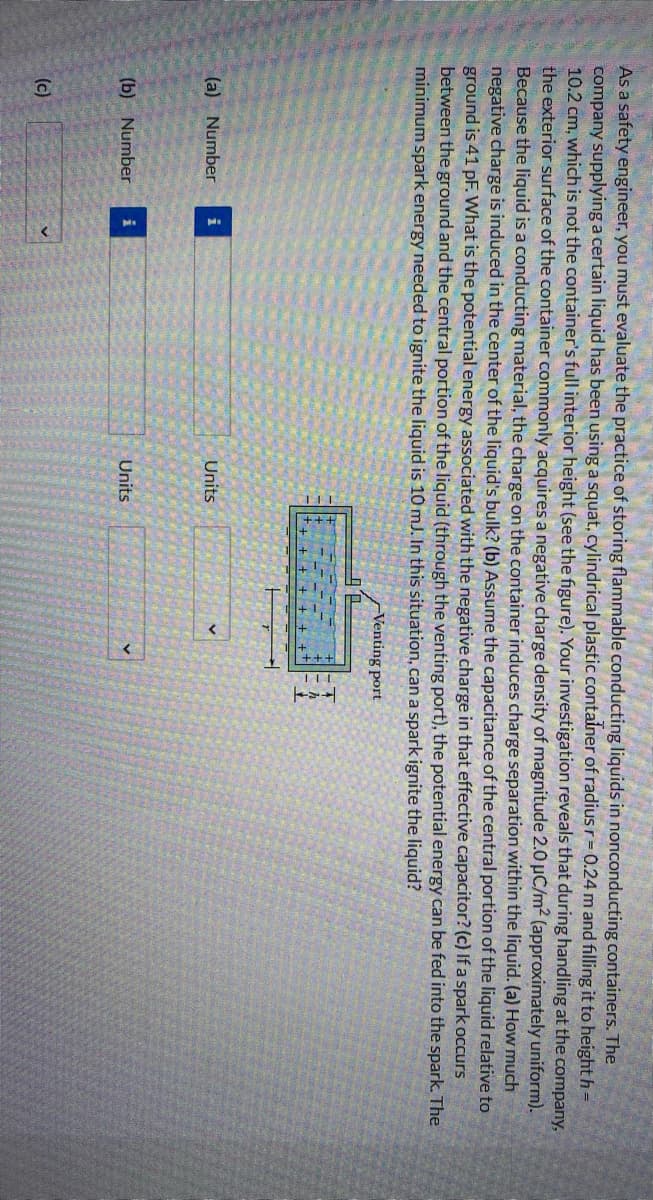As a safety engineer, you must evaluate the practice of storing flammable conducting liquids in nonconducting conta company supplying a certain liquid has been using a squat, cylindrical plastic container of radius r= 0.24 m and filling 10.2 cm, which is not the container's full interior height (see the figure). Your investigation reveals that during handli the exterior surface of the container commonly acquires a negative charge density of magnitude 2.0 µC/m2 (approxin Because the liquid is a conducting material, the charge on the container induces charge separation within the liquid. negative charge is induced in the center of the liquid's bulk? (b) Assume the capacitance of the central portion of the l ground is 41 pF. What is the potential energy associated with the negative charge in that effective capacitor? (c) If a s between the ground and the central portion of the liquid (through the venting port), the potential energy can be fed in minimum spark energy needed to ignite the liquid is 10 mJ. In this situation, can a spark ignite the liquid? -Venting port (a) Number i Units (b) Number Units (c)
As a safety engineer, you must evaluate the practice of storing flammable conducting liquids in nonconducting conta company supplying a certain liquid has been using a squat, cylindrical plastic container of radius r= 0.24 m and filling 10.2 cm, which is not the container's full interior height (see the figure). Your investigation reveals that during handli the exterior surface of the container commonly acquires a negative charge density of magnitude 2.0 µC/m2 (approxin Because the liquid is a conducting material, the charge on the container induces charge separation within the liquid. negative charge is induced in the center of the liquid's bulk? (b) Assume the capacitance of the central portion of the l ground is 41 pF. What is the potential energy associated with the negative charge in that effective capacitor? (c) If a s between the ground and the central portion of the liquid (through the venting port), the potential energy can be fed in minimum spark energy needed to ignite the liquid is 10 mJ. In this situation, can a spark ignite the liquid? -Venting port (a) Number i Units (b) Number Units (c)
Physics for Scientists and Engineers: Foundations and Connections
1st Edition
ISBN:9781133939146
Author:Katz, Debora M.
Publisher:Katz, Debora M.
Chapter23: Electric Forces
Section: Chapter Questions
Problem 66PQ: Two helium-filled, spherical balloons, each with charge q, are tied to a 5.00-g mass with strings of...
Related questions
Question

Transcribed Image Text:As a safety engineer, you must evaluate the practice of storing flammable conducting liquids in nonconducting containers. The
company supplying a certain liquid has been using a squat, cylindrical plastic container of radius r= 0.24 m and filling it to height h
10.2 cm, which is not the container's full interior height (see the figure). Your investigation reveals that during handling at the company,
the exterior surface of the container commonly acquires a negative charge density of magnitude 2.0 µC/m2 (approximately uniform).
Because the liquid is a conducting material, the charge on the container induces charge separation within the liquid. (a) How much
negative charge is induced in the center of the liquid's bulk? (b) Assume the capacitance of the central portion of the liquid relative to
ground is 41 pF. What is the potential energy associated with the negative charge in that effective capacitor? (c) If a spark occurs
between the ground and the central portion of the liquid (through the venting port), the potential energy can be fed into the spark. The
minimum spark energy needed to ignite the liquid is 10 mJ. In this situation, can a spark ignite the liquid?
-Venting port
(a) Number i
Units
(b) Number
Units
(c)
Expert Solution
This question has been solved!
Explore an expertly crafted, step-by-step solution for a thorough understanding of key concepts.
This is a popular solution!
Trending now
This is a popular solution!
Step by step
Solved in 2 steps with 2 images

Knowledge Booster
Learn more about
Need a deep-dive on the concept behind this application? Look no further. Learn more about this topic, physics and related others by exploring similar questions and additional content below.Recommended textbooks for you

Physics for Scientists and Engineers: Foundations…
Physics
ISBN:
9781133939146
Author:
Katz, Debora M.
Publisher:
Cengage Learning

Principles of Physics: A Calculus-Based Text
Physics
ISBN:
9781133104261
Author:
Raymond A. Serway, John W. Jewett
Publisher:
Cengage Learning

College Physics
Physics
ISBN:
9781305952300
Author:
Raymond A. Serway, Chris Vuille
Publisher:
Cengage Learning

Physics for Scientists and Engineers: Foundations…
Physics
ISBN:
9781133939146
Author:
Katz, Debora M.
Publisher:
Cengage Learning

Principles of Physics: A Calculus-Based Text
Physics
ISBN:
9781133104261
Author:
Raymond A. Serway, John W. Jewett
Publisher:
Cengage Learning

College Physics
Physics
ISBN:
9781305952300
Author:
Raymond A. Serway, Chris Vuille
Publisher:
Cengage Learning

College Physics
Physics
ISBN:
9781285737027
Author:
Raymond A. Serway, Chris Vuille
Publisher:
Cengage Learning